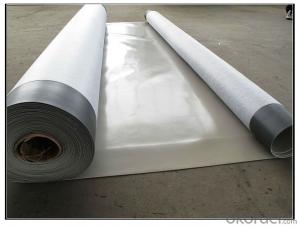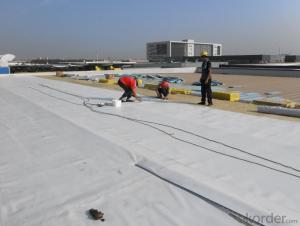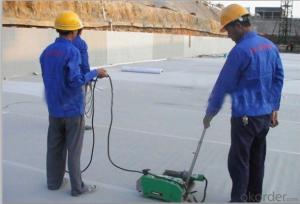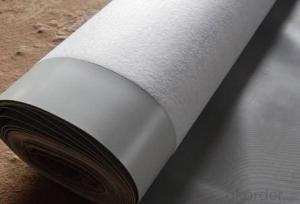PVC Waterproofing Menbrane for Roofing Construction
- Loading Port:
- Shanghai
- Payment Terms:
- TT OR LC
- Min Order Qty:
- 20000 m²
- Supply Capability:
- 5000000 m²/month
OKorder Service Pledge
OKorder Financial Service
You Might Also Like
PVC Waterproofing Menbrane for Roofing Construction
Product Description of PVC Waterproofing Menbrane for Roofing Construction:
PVC Membrane Waterproof /Waterproofing membrane For Roof is a new polymer waterproof membrane. The PVC Membrane Waterproof /Waterproofing membrane For Roof raw material is polyvinyl chloride resin, mixed with plasticizer, filler, antioxygen, ultraviolet absorber and other auxiliaries.
Thickness: 1.2mm/1.5mm/1.8mm/2.0mm
Width:2050mm
Length:20m( Special specifications can be customized)
Size: 2.05mx20m
Color: white/grey, or any other colors.
Features of PVC PVC Waterproofing Menbrane for Roofing Construction:
1. Excellent anti-aging property.
2. Puncture- resistant.
3. Welding construction,
4. High tensile strength, good elongation, good dimensional stability.
5. Good plasticity.
6. It has self-extinguishing from fire property.
7. Materials surface is smooth, fast color, stain resistance.
8. More wide, Wastage become less when being used.
Classification of PVC Waterproofing Menbrane for Roofing Construction:
1. N: Homogeneous PVC membrane
2. L: PVC membrane with fabric backing
3. W: Reinforced PVC membrane
Advantage of PVC Waterproofing Menbrane for Roofing Construction:
1.) Mixing automation. Apply automatic temperature control automatic time control and automatic feed control.
2.) Extrusion equipment uses twin screw coextrusion. Screw temperature uses computer automatic temperature control system.
3.) Handpiece uses large width didhead extrusion equipment.
4.) Sophisticated three-roller calender equipment. The space between equiment is controlled by automation system.
Technical Data of PVC Waterproofing Menbrane for Roofing Construction:
No. | Item | Model Ⅱ | |
1 | Tensile Strength Mpa ≥ | 12.0 | |
2 | Elongation at break% ≥ | 250 | |
3 | Shrinkage rate % ≤ | 2.0 | |
4 | Flexibility at low temperature | No crackle at -25oC | |
5 | Water tightness | Watertight | |
6 | Puncture resistance | Watertight | |
7 | Heat aging treatment | Appearance | Free from bubble, crack, cohesion and void |
Change rate of tensile strength % | +20oC | ||
Change rate of elongation at break | |||
Flexibility at low temperature | No crack at -20oC | ||
8 | Chemical corrosion resistance | Change rate of tensile strength % | +20 |
Change rate of elongation at break | |||
Flexibility at low temperature | No crack at -20oC | ||
9 | Artificial weathering | Change rate of tensile strength % | +20 |
Change rate of elongation at break | |||
Flexibility at low temperature | No crack at -20oC | ||
Application of PVC Waterproof Membrane in 1.2mm Thickness:
1) All kinds of roofs, such as steel structure roof, planted roof etc.
2) Underground engineering, such as building basement, subways, tunnels, air raid shelter, etc.
3) Other projects like artificial lake, dam, water reservoir, grain storehouse, etc.
Images of PVC Waterproofing Menbrane for Roofing Construction:

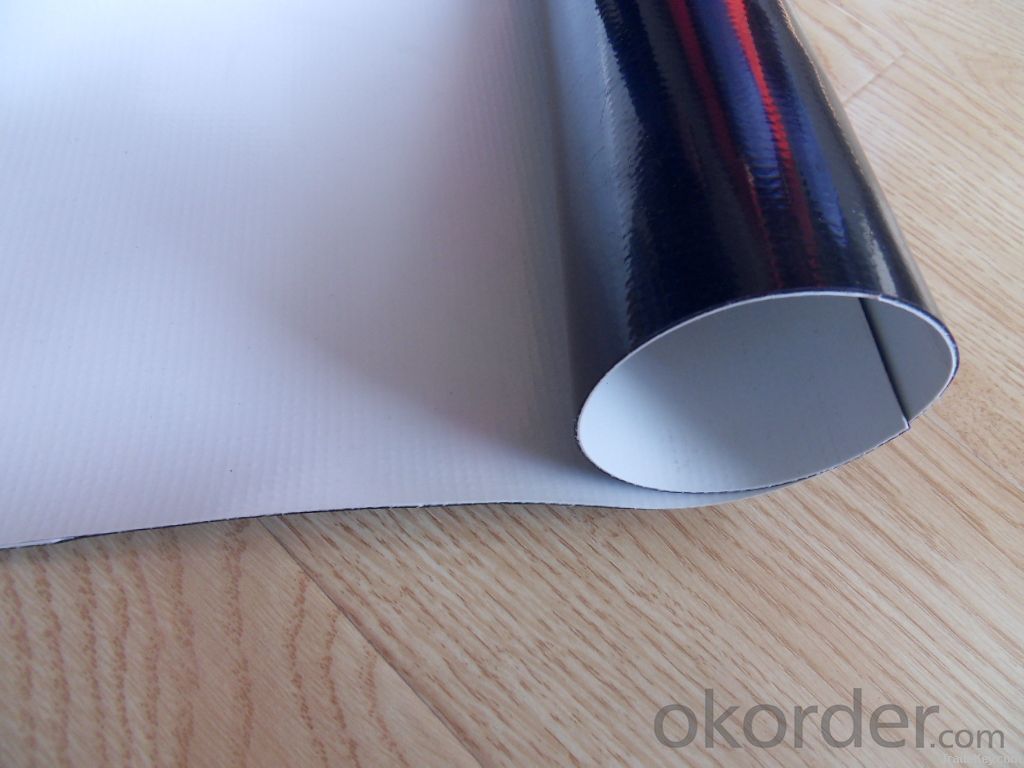
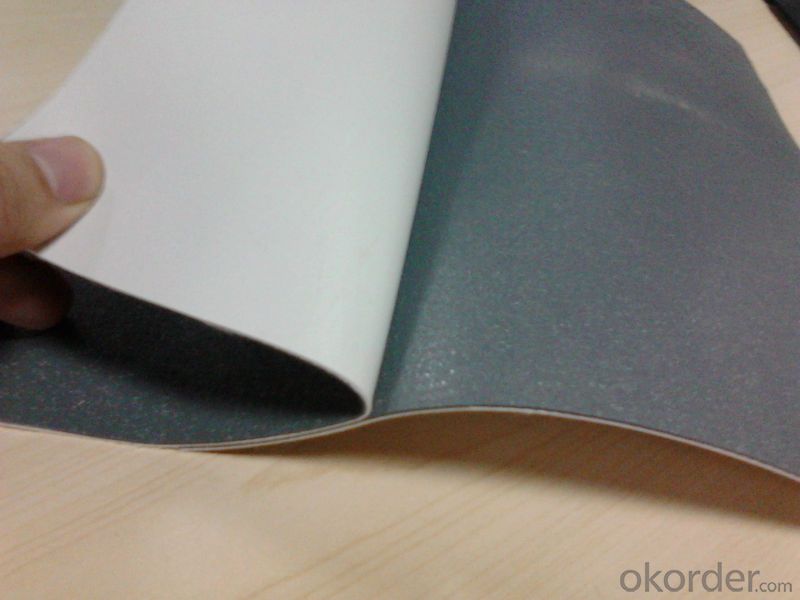
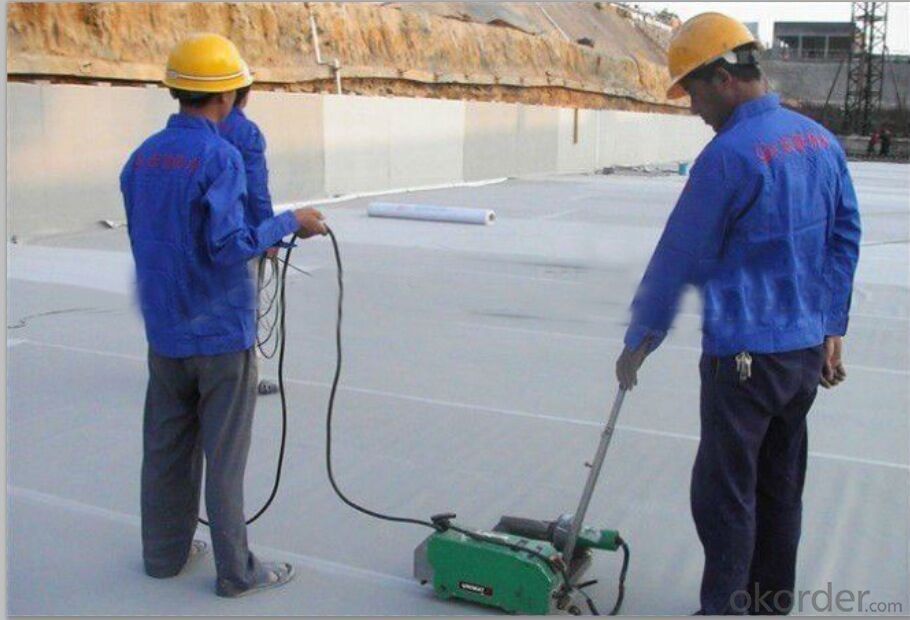

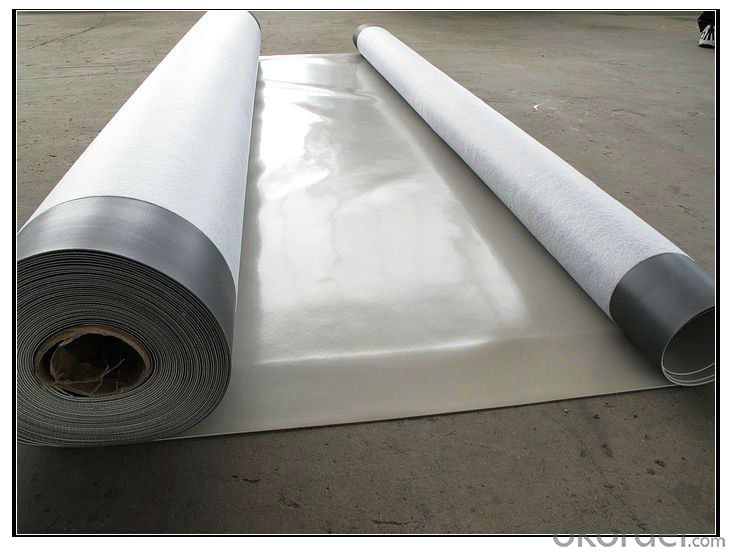
FAQ:
1. Can you produce 4m width?
Yes, no problem for us. We have four bases in China, largest one in this field.
2. How many quantity in one 20'' container for 1.2mm and 1.5mm?
480rolls, 11520m2 for 1.2mm and 400rolls, 9600m2 for 1.5mm
3. Can you provide free samples?
Yes, our samples are free, but express fees usually on buyer's account.
- Q:Can a waterproofing membrane be used in commercial construction?
- Certainly, a waterproofing membrane is a viable option for utilization in commercial construction. In actuality, it serves as an essential element throughout the construction process. Its purpose is to establish a barrier against moisture, effectively preventing water infiltration and safeguarding the structure from potential water-related harm. This element proves particularly crucial in commercial edifices, where water poses a significant threat to the structural integrity. It can lead to severe problems, including mold proliferation, material deterioration, and even compromise the foundation's stability. Waterproofing membranes find widespread application in various areas of commercial construction, encompassing basements, roofs, foundations, and even external walls. They come in diverse forms, such as sheets, liquid coatings, or spray-applied membranes, allowing for flexibility and adaptability in different construction scenarios. All in all, incorporating a waterproofing membrane in commercial construction endeavors is a prudent investment, ensuring the long-lasting endurance and efficiency of the building.
- Q:How does a waterproofing membrane handle expansion and contraction of a surface?
- A waterproofing membrane is specifically designed to accommodate the expansion and contraction of a surface. It is composed of flexible materials that can stretch and contract without compromising its integrity. This allows the membrane to move with the surface, preventing any cracks or damage that could lead to water infiltration. The membrane is typically installed with overlapping seams, creating a continuous barrier that can expand and contract as needed. These seams are often reinforced to provide additional strength and durability. Furthermore, the membrane is usually applied in multiple layers, which adds to its flexibility and ability to handle surface movement. In addition to the material composition, the installation process is crucial in ensuring the membrane can handle expansion and contraction. Properly trained professionals will consider the specific conditions of the surface, such as temperature fluctuations and structural movement, and install the membrane accordingly. They may use techniques such as hot-air welding or adhesive bonding to create a secure and flexible bond between the membrane and the surface. Overall, a waterproofing membrane is designed to accommodate the natural expansion and contraction of a surface. Its flexibility, reinforced seams, and multi-layer construction allow it to move with the surface without compromising its waterproofing capabilities, ensuring long-term protection against water infiltration.
- Q:Can a waterproofing membrane be used for exterior applications?
- Yes, a waterproofing membrane can be used for exterior applications. Waterproofing membranes are often used on roofs, balconies, decks, foundations, and other exterior surfaces to provide a protective barrier against water and moisture infiltration. These membranes are specifically designed to withstand outdoor conditions and can effectively prevent water damage and leaks in exterior structures.
- Q:Can a waterproofing membrane be applied on top of existing coatings?
- Yes, it is possible to apply a waterproofing membrane on top of existing coatings. However, there are certain factors that need to be considered before doing so. Firstly, the condition and adherence of the existing coating should be assessed to ensure it is in good condition and capable of providing a suitable substrate for the waterproofing membrane. If the existing coating is loose, damaged, or incompatible with the waterproofing membrane, it may need to be removed or repaired before applying the membrane. Additionally, compatibility between the existing coating and the waterproofing membrane is crucial. Different types of coatings and membranes may not adhere well to each other, leading to poor performance or failure. It is important to consult the manufacturer's recommendations and seek professional advice to ensure compatibility between the existing coating and the chosen waterproofing membrane. Furthermore, proper surface preparation is essential for the successful application of a waterproofing membrane on top of existing coatings. The surface should be thoroughly cleaned, free from dirt, debris, and any loose or flaking coating. Additionally, any cracks, holes, or imperfections in the existing coating should be repaired before applying the membrane. In conclusion, while it is possible to apply a waterproofing membrane on top of existing coatings, it is crucial to assess the condition and adherence of the existing coating, ensure compatibility between the coating and membrane, and properly prepare the surface for successful application. Seeking professional advice and following manufacturer's recommendations are highly recommended to ensure the effectiveness and longevity of the waterproofing system.
- Q:Is a waterproofing membrane resistant to solvents or chemical spills?
- Yes, a waterproofing membrane is typically resistant to solvents or chemical spills. Waterproofing membranes are designed to provide a protective barrier against water and other liquids, including solvents and chemicals. These membranes are often made of materials such as PVC, TPO, or EPDM, which have excellent resistance to various solvents and chemicals. However, the specific resistance may vary depending on the type and composition of the membrane. It is always recommended to check the manufacturer's specifications and consult with professionals to ensure the membrane's compatibility with specific solvents or chemicals before installation.
- Q:Can waterproofing membranes be used on roofs with slopes?
- Yes, waterproofing membranes can be used on roofs with slopes. These membranes are designed to provide a protective barrier against water infiltration and are commonly used on roofs with varying degrees of slope to prevent leaks and water damage.
- Q:Can a waterproofing membrane be used in conjunction with vapor barriers?
- Yes, a waterproofing membrane can be used in conjunction with vapor barriers. In fact, it is often recommended to use both to ensure comprehensive protection against moisture. Waterproofing membranes are designed to prevent water from penetrating through a surface, such as a roof or foundation, while vapor barriers are designed to prevent the passage of water vapor. By using both, you can effectively prevent both liquid water and water vapor from causing damage to a structure. The waterproofing membrane acts as a physical barrier to prevent water from entering, while the vapor barrier prevents the buildup of moisture within the structure. This combination can be particularly beneficial in areas with high humidity or where there is a risk of water intrusion.
- Q:Are waterproofing membranes resistant to hail damage?
- Yes, waterproofing membranes are generally resistant to hail damage. They are designed to withstand various weather conditions, including hailstorms, without getting damaged or compromised.
- Q:Is a waterproofing membrane suitable for use in areas with high groundwater levels?
- Yes, a waterproofing membrane is suitable for use in areas with high groundwater levels. The membrane acts as a barrier, preventing water from seeping into structures and causing damage. It provides an effective solution for protecting foundations, basements, and other below-grade areas from water infiltration.
- Q:The shortcomings of polypropylene waterproofing, and the shortcomings of modified asphalt waterproofing membrane
- but the current domestic Still less match with the binder, because the environment and bonding materials and other factors often lose their bond function in advance, resulting in water failure will be self-evident; then waterproofing membrane after the construction of the protection And the leak after the maintenance is also a problem, exposed to the outside of the waterproof layer of foreign mechanical damage prevention is very important, waterproof membrane and grass-roots bonding, whether it is full shop, shop, shop, empty shop, The grassroots will be between the water layer, regardless of any part of the penetrating breakage, degumming, leakage of glue (even if there is only one), the entire level of its connection with the waterproof function will all decline, if not Find damaged and defective parts, the local repair is not possible, then only redo waterproof layer. So it is better to waterproof polypropylene
1. Manufacturer Overview |
|
|---|---|
| Location | |
| Year Established | |
| Annual Output Value | |
| Main Markets | |
| Company Certifications | |
2. Manufacturer Certificates |
|
|---|---|
| a) Certification Name | |
| Range | |
| Reference | |
| Validity Period | |
3. Manufacturer Capability |
|
|---|---|
| a)Trade Capacity | |
| Nearest Port | |
| Export Percentage | |
| No.of Employees in Trade Department | |
| Language Spoken: | |
| b)Factory Information | |
| Factory Size: | |
| No. of Production Lines | |
| Contract Manufacturing | |
| Product Price Range | |
Send your message to us
PVC Waterproofing Menbrane for Roofing Construction
- Loading Port:
- Shanghai
- Payment Terms:
- TT OR LC
- Min Order Qty:
- 20000 m²
- Supply Capability:
- 5000000 m²/month
OKorder Service Pledge
OKorder Financial Service
Similar products
New products
Hot products
Related keywords
